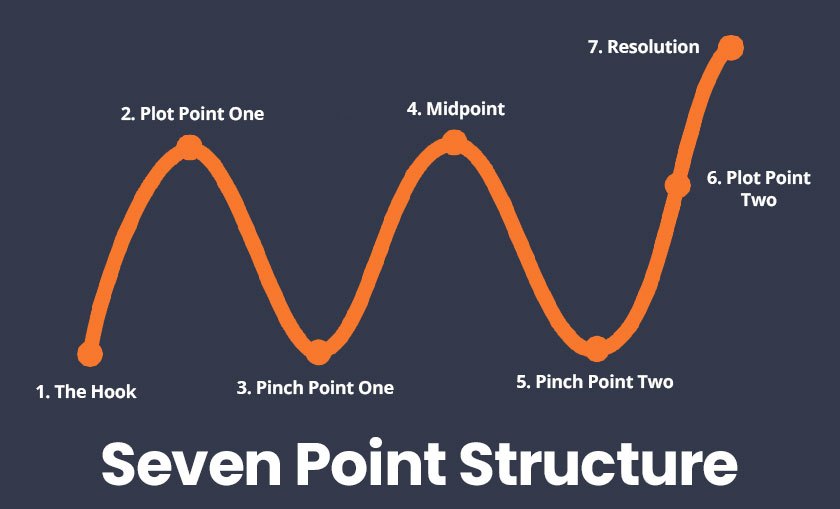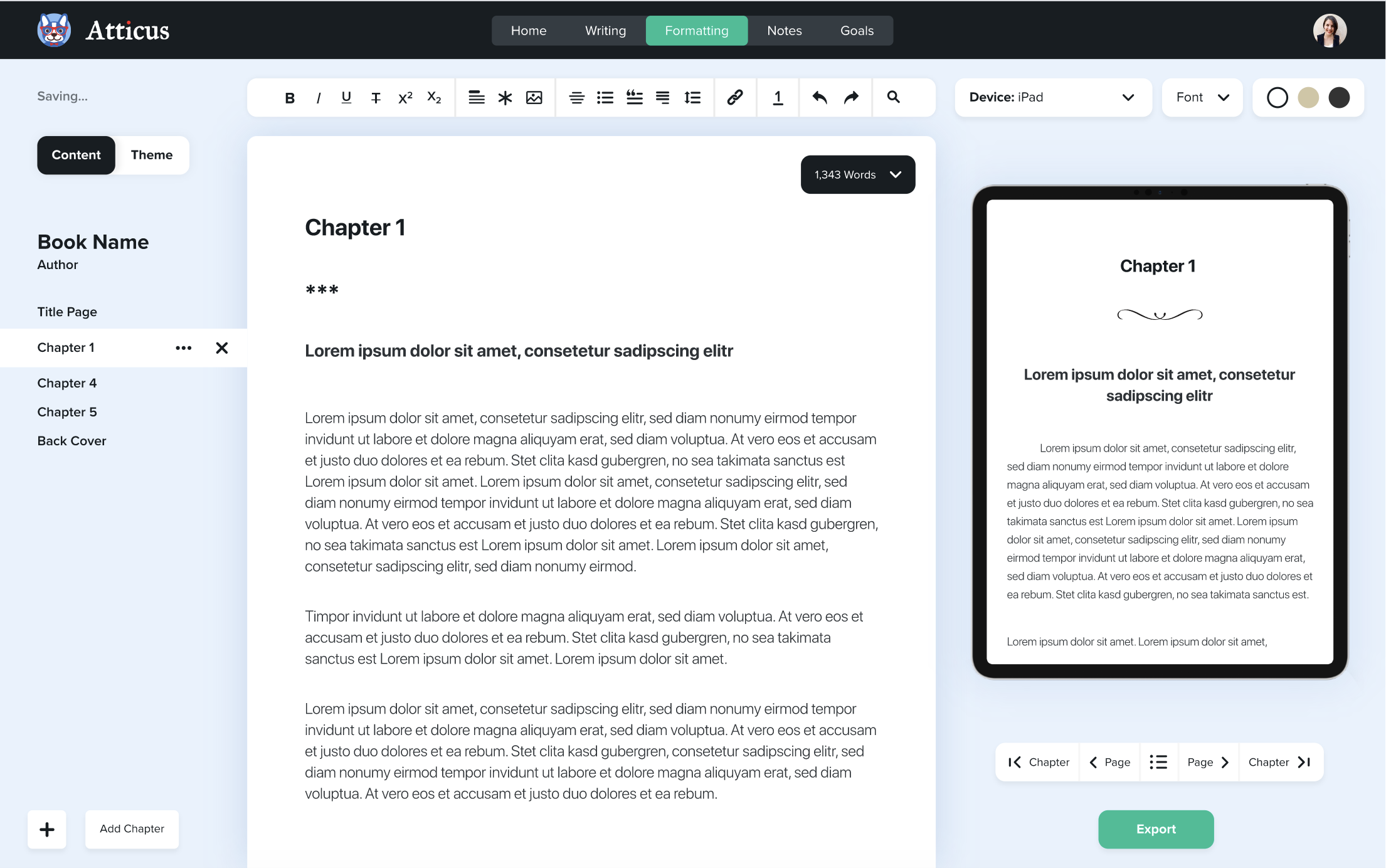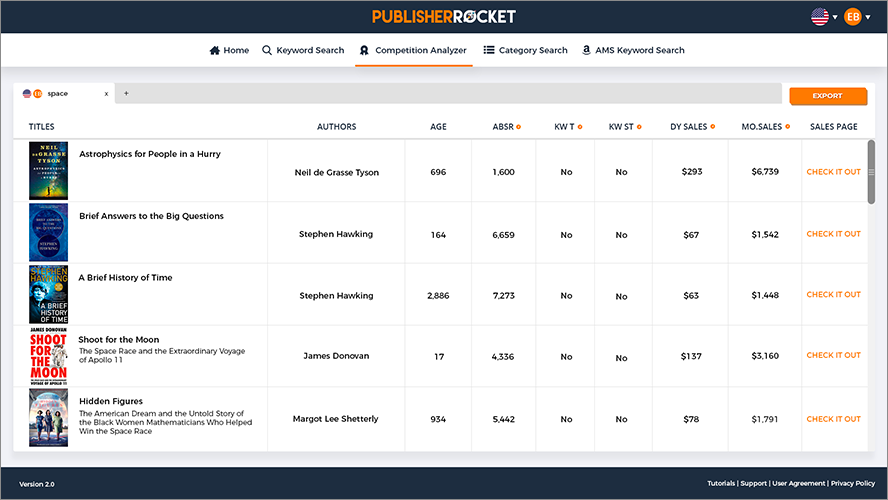Most writers use some kind of structure when planning a story.
The classic go-to? The three-act structure.
Beginning, middle, end. Clean. Simple. Effective.
And it works… mostly because our brains are wired for stories that build, twist, and land.
But there’s another framework worth knowing: the Seven-Point Story Structure.
It came from Dan Wells around 2010, and it breaks your plot into seven clear beats. It’s like a zoomed-in version of the three-act arc, but without boxing you in.
Even writers who hate outlines swear by it.
Because it doesn’t tell you what to write… it helps you see what’s missing.
And that’s especially useful during early drafts, rewrites, or anytime your plot feels like it’s sinking in wet cement.
In this post, I’ll walk you through all seven points, show how they play out in a story like Rocky, and give you tips to make the structure your own.
Side note: We recommend Plottr as our top plotting tool to fabricate stories using the 7-point Story Structure and many other Story Structures. If you purchase Plottr, we do get a small commission from that, but there is no extra cost and every bit goes to Dave's coffee fund. More on Plottr later.
Table of contents
Seven-Point Story Structure (Explained Simply)

Before we get into examples, let’s break down what each of the seven points actually means.
If you’ve used the three-act structure before, this will feel familiar. The bones are the same. But instead of three big chunks, you get seven specific beats to work with.
That makes it easier to build tension, pace your story, and keep things moving.
Here’s a quick rundown of each point:
- The Hook: This is where we meet the protagonist and get a glimpse of their world. Nothing major has happened yet, but you’re planting seeds. You’re showing readers what “normal” looks like before the story flips it upside down.
- Plot Point 1: This is the moment that kicks off the story. A decision, a discovery, a disruption — whatever it is, it drags the character out of their old life and into something new. The real plot starts here.
- Pinch Point 1: Now we apply pressure. Something shows up to raise the stakes… an antagonist, a looming threat, or some kind of conflict. This beat reminds us what’s on the line.
- Midpoint: The character shifts from passive to active. They stop reacting to events and start making moves. This is a major turning point, and it usually changes the direction of the story.
- Pinch Point 2: Everything falls apart. The character faces a big setback, loses something they care about, or starts to doubt themselves. This is often the lowest point in the story emotionally.
- Plot Point 2: Breakthrough. The character gets the insight, tool, or strength they need to face the final challenge. They’re not across the finish line yet, but the path forward is finally clear.
- Resolution: The story wraps up. We see what changed, what didn’t, and where the character ends up. The tone of the ending can vary, but it should feel earned. The arc is complete.
Format Beautiful Professional Books
Easy to use, and and full of amazing features, you can quickly turn your book into a professional book.
Check It OutRocky, in Seven Points
Let’s map the Seven-Point Story Structure onto something familiar: Rocky.
Not the sequels. Just the original.
(The one that mattered.)
- The Hook: Rocky Balboa is a small-time boxer in Philly. He’s broke. He’s aging. And most people see him as a joke. But there’s a spark buried under the surface… he just needs someone to believe in him. He’s stuck in survival mode, hoping for a break that never comes.
- Plot Turn 1: That break shows up in the form of Apollo Creed, the reigning heavyweight champ. His opponent drops out, so Apollo picks Rocky (a no-name) to fill the spot. A publicity stunt. A guaranteed win. But for Rocky, it’s something he’s never had: a real shot.
- Pinch Point 1: Once the offer sinks in, the pressure hits. Rocky knows he’s out of his depth. Everyone around him thinks he’s going to get destroyed. And part of him agrees. The dream starts to feel like a trap.
- Mid-Point: Rocky flips the switch. He decides to take it seriously. He trains hard. He wakes up early. He cleans up his act. He asks Mickey to coach him, and they start putting in the work. This is the shift from hope to commitment.
- Pinch Point 2: The night before the fight, doubt comes flooding back. Rocky knows he can’t win. Not really. So he lowers the bar. His goal isn’t to beat Apollo… it’s to go the distance. If he can stay standing for all 15 rounds, that’s his victory.
- Plot Point 2: Bell rings. First round. And Rocky knocks Apollo down. Just once. But it’s enough. Enough to change the energy of the fight, enough to show that Rocky didn’t come here to be a joke. He came to prove something. And he’s not leaving quietly.
- Resolution: Rocky survives all 15 rounds. He doesn’t win the match, but that was never the point. He stood his ground. He went the distance. And for the first time in his life, he earned respect… from the world, from Apollo, and from himself.
5 Tips for Writing a Seven-Point Story
The Seven-Point Structure isn’t complicated.
But that doesn’t mean most people use it well.
Here are five ways to make it actually work for you… whether you’re writing fiction, memoir, or something weird and genre-bending you can’t even label yet.
Tip 1: Work Backward
Start with the end.
What happens in the final scene? What has the main character gained, lost, or learned?
Once you know that, you can reverse-engineer the rest of the structure. Clarity at the finish line helps you build tension that actually leads somewhere.
Tip 2: Nail the Hook
The hook isn’t just “Chapter One.” It’s your shot to make us care.
Don’t just show a normal day in your character’s life. Show us what they’re missing. What they want but don’t have. What’s about to break.
The stronger the hook, the harder it is to put the story down.
Tip 3: Get the Midpoint Right
This is where your story stops drifting and starts driving.
The main character has to stop reacting and start deciding. It’s the heartbeat of your plot. If your midpoint is soft or muddled, the whole second half of your story will sag.
Tip 4: Don't Skip the Pinches
Pinch Points are the gut punches. One early, one late.
They remind the reader what’s at stake and push the character deeper into the fire. If the stakes don’t escalate, the reader stops caring.
Pinches are pressures that tightens the whole structure, so give 'em their due.
Tip 5: Use it for Anything
You can map a rom-com with this. Or a dystopian thriller. Or a weird little literary novella.
Doesn’t matter. The Seven Points aren’t a formula, they’re a framework. And once you internalize it, you’ll start to see it everywhere (because it works).
The Downsides of the 7-Point Story Structure
No framework is perfect.
The Seven-Point Structure is solid, but it’s not without a few quirks that can trip up writers if you’re not careful.
The word “Hook” is vague.
Some writers treat the hook like a throwaway intro. Others cram everything into it like a five-minute movie trailer.
It’s too open to interpretation.
If you’re using this framework, define the hook clearly for yourself. Otherwise, your story will feel like it starts twice.
The “Resolution” is trying to do too much.
In this structure, the Resolution includes both the climax and the falling action. That’s a lot of story to squeeze into one beat.
You may want to break it out. Let your climax hit hard, then give your reader room to breathe before you close the book.
It’s easy to treat the points like a checklist.
This isn’t a to-do list.
Just because you checked all seven boxes doesn’t mean you have a working story. The power of the structure is in how each beat connects and escalates.
You still need heart, character, pacing, and all the things that make writing good.
Why Use the Seven Point Story Structure?
Because it helps.
Not every writer needs it. Some of you can just sit down, start typing, and stumble your way into a solid story. If that’s you, great. Skip this structure and keep doing what works.
But if you’ve got a strong character and no idea what to do with them…
If you’re great at beginnings but keep writing yourself into a corner…
If your middle always turns into a swamp and your ending feels rushed or random…
The Seven-Point Structure can help you fix that.
It gives you a skeleton to build on. Not a formula. Not a prison. Just seven beats to guide your plot and keep it moving forward. Especially useful when you're stuck, revising, or just need to see the shape of your story more clearly.
And if you want a tool that helps you map it all out visually, we recommend Plottr.
It has a built-in template for the Seven-Point Structure, along with dozens of other frameworks. You can sketch scenes, plan character arcs, and actually see how your story fits together. That's why it's Dave's choice for the best outlining software.
Worth checking out… especially if you’re the kind of writer who likes seeing the whole picture before diving in.
—
An earlier version of this article was authored by Jason Hamilton. It has been rewritten for freshness and comprehensiveness.









